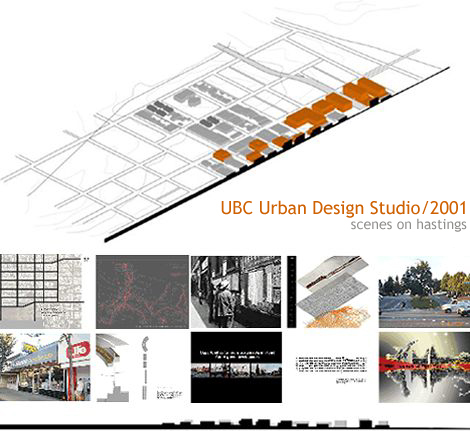
|
This
web site features the outcomes of the Fall 2001 Urban Studio, "Scenes
on Hastings", a joint effort of the UBC Schools of Architecture,
Community and Regional Planning, and the Landscape Architecture
Program. The studio, offered during the fall of 2001, was directed
by Professors Patrick Condon (Landscape Architecture Program), Penny
Gurstein (School of Community and Regional Planning), Martin Lewis
and Ali Shakarchi (School of Architecture),
|
|
| Overview | ||||||||||||||||||||||||
|
The
general aim of the UBC Urban Studio is to use urban design to explore
emerging issues within the changing physical fabric of the Greater
Vancouver Region and larger Georgia Basin. The site chosen for this
year's Urban Studio is the Hastings Stree corridor.
Studio Intent: The study area for this year's studio is Hastings Street, from its origin in Downtown Vancouver to its termination below SFU in Burnaby. The intent of the studio is to provide ideas and visions for the disparate and complex urban armature of Hastings Street. Students in the combined studio involving planning, architecture, and landscape architecture will conduct the visioning project, working closely with citizens, elected officials and municipal staff for the first 6 - 7 week phase of the project. The second phase of the project will involve just planning and architecture students as landscape architecture students will be otherwise committed. Studio Goal: The goal of the 2001 Urban Studio is: To instill in students a basic ability to grapple with the astonishingly complex competing demands made on urban space, and to contribute proposals for this contested ground that best resolve these competing demands. Studio
Objectives:
|